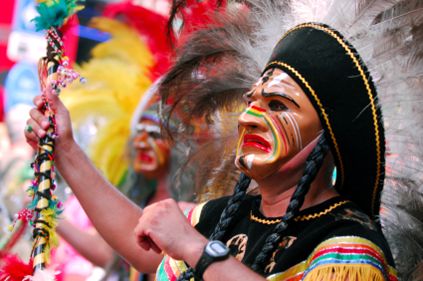|
Oruro Carnival – Carnaval de Oruro ESPAÑOL The Oruro Carnival (Carnaval de Oruro) is also known as the Diablada and is the number one tourist attraction in Bolivia. Oruro is located 230 kilometers (about 3-4 hours by car or bus) from La Paz, high on the Altiplano (highlands) in the Andes Mountains and is traditionally a mining city. Use the links provided for more.
Carnival is celebrated in many countries around the world and in Bolivia too. But Carnival traditions have been adapted and changed to suit local customs. That's why even within Bolivia it is celebrated in many different ways in different regions. The best known Carnival celebration in Bolivia is the Carnaval of Oruro. Carnaval begins on different dates each year, but that's because it is timed to end on Fat Tuesday (known as Mardi Gras in French and Martes Gordo in Spanish). This is exactly 40 days prior to Easter, on the day Lent begins, which in English is called Ash Wednesday. Lent is when Roman Catholics (over 90% of Bolivian profess to be Catholic) begin a 40-day period in which they do not eat red meat. And this is precisely where the name CARNAVAL comes from. In Spanish (which comes from Latin) the word "meat" is "carne". In Latin "carne levare" means to "take away the meat". In Bolivia, the 40-day meatless tradition is no longer observed. Catholics here only fast from meat on Fridays during the one-month Lenten season. In Oruro, the Carnaval tells the story of how the Spaniards conquered the Aymara and Quechua populations of the Andes. Some dancers wear costumes that represent the robes worn by Spanish Catholic priests who attempted to convert the indigenous peoples to Catholicism. Other costumes represent the Spanish conquerors themselves, complete with 16th century Spanish helmets, swords and even horses (unknown in the Americas until European explorers brought them over on ships). Others represent slaves that were brought over from Africa to work in mining, and so on. But the most colorful and elaborate costumes are the DIABLOS (devils). Because Oruro is a mining town, and primarily indigenous, locals have mixed their traditional beliefs with Catholicism. Miners believe that the Devil is lord and master of the mines. During the Oruro Carnival days they dance to appease the spirits and frequently make promises or offer sacrifices, beer, food, and coca to the “Tío” (which means Uncle, but is a statuette of the devil). In the mines they also take him coca leaves and cigarettes which they light before entering the mine to keep him happy. They believe if they do so he will not be angry that they are extracting the wealth from the mines and will keep them safe. It’s also the reason they dance the Diablada (the Devil’s Dance). However, the Diablada is only one of the many dances and costumes used during the Carnaval parade. Carnival is celebrated like this in Western Bolivia. In the East traditions vary greatly. The Aymara and Quechua did not live in Eastern Bolivia before and only began to massively migrate to the area about a decade ago. Here Carnival is more like Carnaval in Rio de Janeiro. Read this page on Carnival in Bolivia to learn about Carnaval in other areas. In the Oruro Carnival costumes are extremely ornate and expensive and are made by hand far in advance. Groups of dancers also prepare months prior and practice both with and without their costumes to get into shape as they’ll dance and drink for several days. Click here to read about the origins of the Carnaval de Oruro and the Diablada. Bolivia has dedicated a lot of publicity and has spared no expense to advertising the Carnival and today it is the most sought-after tourist attraction in Bolivia. If you plan to attend the upcoming Carnaval de Oruro, you need to prepare and make hotel and tour reservations at least three months in advance.     |
